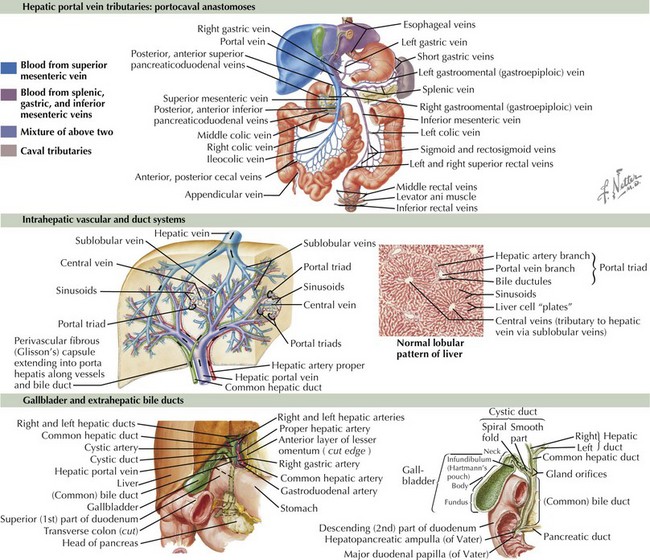115 Hepatobiliary Disease
Normal Anatomy and Physiology
The liver arises from endoderm between the third and fourth weeks of gestation. The liver is important in the production of bile, synthesis of coagulation factors, metabolism of proteins and glucose, and biotransformation of drugs and toxins. It consists of four lobes: right, left, caudate, and quadrate. An understanding of the liver’s blood supply is useful when considering the consequences of portal hypertension (Figure 115-1). The portal vein and hepatic artery bring blood to the liver. The portal vein, which receives its supply from the splenic vein and mesenteric veins, carries about 75% of the liver’s blood supply. The hepatic artery receives its blood supply from the celiac axis. Blood exits the liver through the hepatic vein, which empties into the inferior vena cava. Bile exits the liver by way of the intrahepatic bile ducts that lead to the right and left hepatic ducts, which merge to form the common hepatic duct. The common hepatic duct merges with the cystic duct from the gallbladder to form the common bile duct, which allows drainage of bile into the duodenum.
Etiology and Pathogenesis
Two common manifestations of hepatobiliary disease are elevations in liver transaminases and jaundice. Elevations of aspartate aminotransferase (AST) and alanine aminotransferase (ALT) arise from hepatocyte injury. Elevations of γ-glutamyl transpeptidase (GGT) and alkaline phosphatase (ALP) result from impaired bile flow. Jaundice results from an elevation in conjugated or unconjugated bilirubin. Unconjugated hyperbilirubinemia occurs in about 60% of full-term infants and is most commonly physiologic jaundice partly caused by the immaturity of the bilirubin conjugation process (see Chapter 100). Unconjugated hyperbilirubinemia may also arise from hemolytic anemia (leading to overproduction of bilirubin) or abnormal bilirubin conjugation. Conjugated hyperbilirubinemia is always considered pathologic (see below).
Clinical Presentation
Hepatobiliary diseases can present as acute fulminant liver failure or can be quiescent with an insidious onset. A thorough history can be very helpful in narrowing down the differential diagnosis of liver disease. Knowledge of the time of onset of all symptoms, including jaundice, is helpful. Breast milk jaundice develops after the seventh day of life, in contrast to breastfeeding jaundice, which occurs in the first week of life. Both of these entities present with unconjugated hyperbilirubinemia. Infants who have conjugated hyperbilirubinemia from the first day of life most likely have a pathologic process. The medical provider should ask about medications taken by the child or the mother (in the case of a breastfed infant). Dark urine, abdominal enlargement, easy bruising, epistaxis, and pruritus may be reported in the history of a patient with liver disease. A patient with portal hypertension may present with hematemesis from an esophageal variceal bleed (Figure 115-2). It is important to ask about potential exposures to viral hepatitis and recent travel. Family history is important to address the possibility of hepatitis B or C transmission.
Differential Diagnosis
The differential diagnosis is vast and can be divided by age (Table 115-1). The provider should always focus on quickly diagnosing diseases requiring urgent treatment. In the Pediatric Acute Liver Failure Registry, the most common diagnosis is indeterminate (49%); additionally, acetaminophen intoxication accounts for 14%, metabolic disease accounts for 10%, autoimmune hepatitis and infectious causes each account for 6%, and non-acetaminophen drug-induced liver disease accounts for 5% of cases. Data from the United Network for Organ Sharing show that the most common diagnoses in children who received a liver transplant from 1995 to 1999 were biliary atresia (BA; 35.6%), viral hepatitis (13%), metabolic liver disease (11.4%), intrahepatic cholestasis (7.9%), TPN (5.4%), and idiopathic cirrhosis (4.8%).
Table 115-1 Differential Diagnosis of Hepatobiliary Disease in Children*
| All Ages | Patients (%) |
|---|---|
| Viral infection: EBV; CMV; hepatitis A, B, and C; herpes simplex virus, echovirus, enterovirus, rubella, parvovirus, adenovirus, toxoplasmosis, syphilis, HIV, varicella | 12.0 |
| Bacterial infection: sepsis, UTI, tuberculosis, Listeria, treponema pallidum | |
| Extrahepatic obstruction: choledochal cyst, bile duct stricture or tumor, cholelithiasis) | |
| Drugs (valproate, isoniazid, acetaminophen) | 1.1 |
| Parenteral nutrition | 5.4 |
| ECMO | |
| CF | 1.9 |
| Ischemia secondary to congenital heart disease, asphyxia, cardiac surgery | |
| Metabolic: AAT deficiency, fatty acid oxidation defect, urea cycle disorders | 11.4 |









